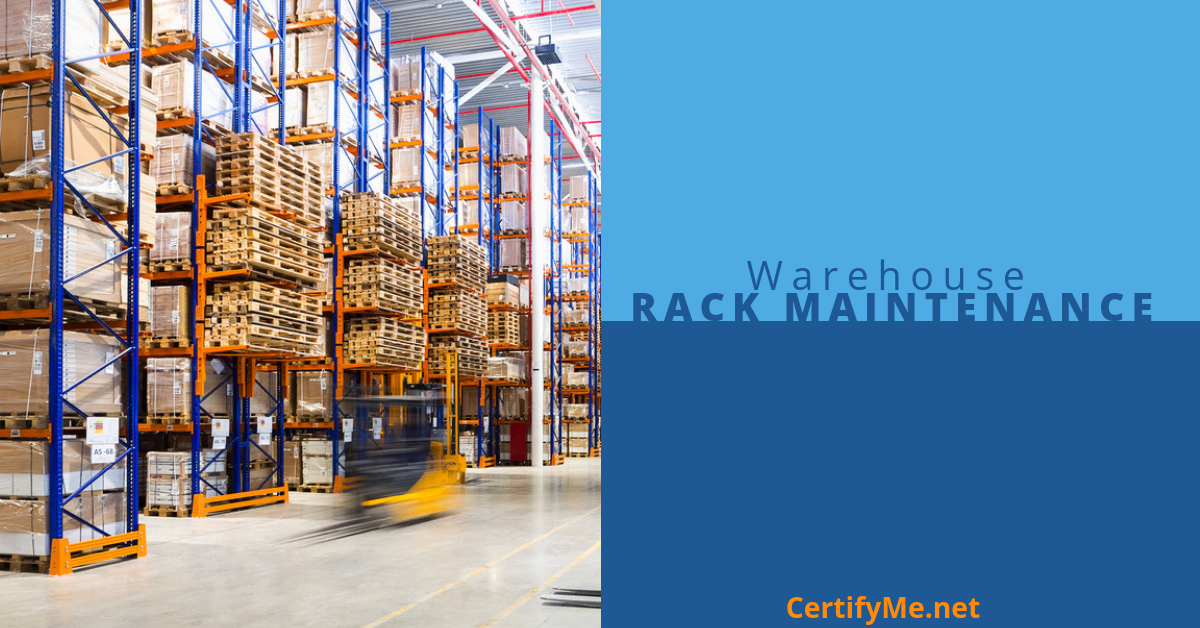Warehouse Racking Strategies to Try in Your Workplace
Posted by: admin on January 18, 2022
 Warehouse racks are the unsung heroes of the fulfillment and distribution industries. When they are used and maintained as intended, they’re the backbone of the entire warehouse. When warehouse racking maintenance gets postponed, though, these simple shelves can become incredibly hazardous. Even though they might look study, warehouse racking demands regular, thorough inspection.
Warehouse racks are the unsung heroes of the fulfillment and distribution industries. When they are used and maintained as intended, they’re the backbone of the entire warehouse. When warehouse racking maintenance gets postponed, though, these simple shelves can become incredibly hazardous. Even though they might look study, warehouse racking demands regular, thorough inspection.
Why Warehouse Racking Fails
There are a number of reasons why warehouse racking might fail. Common causes of rack damage include:
- Collisions from lift trucks operated by careless or untrained drivers
- Overloading and misuse of racks
- Poorly designed system layouts
- Signs of failure aren’t always obvious to the untrained eye. Rack damage can be hidden from view by shelves stacked with inventory. These include bent columns, sheared or crushed frames, damaged footplates, loose or missing anchor bolts, and more.
Rack damage can also be caused by workers overloading shelves to save time and fill empty spaces without regard to weight limitations. Changes in the types and weights of inventory being stored may require adjustments in the way the rack system is used. These changes are sometimes overlooked or ignored, which can result in a potentially unsafe workplace.
Determining Rack Soundness and Safety
Don’t wait for a warehouse accident to happen. The first step in determining the condition of warehouse racks is to establish a regular inspection schedule. These rack damage checks should be performed by a qualified individual who’s familiar with storage rack systems. Just how often should warehouse racking be inspected? Inspections should be conducted at least annually, and preferably more often. Incidents such as a lift truck collision or earthquake warrant re-inspections. Increased warehouse activity and heavier traffic are also reasons for an inspection since they increase the chances of racks sustaining collision damage.
Rack systems’ uses can change as a business evolves. Most systems, however, are designed for specific applications and include limitations on configurations, rack heights, and max load. When these change, racks sometimes suffer damages that go undetected.
Changes in building codes can also affect the inspection schedule. A rack system installed under previous codes may have been grandfathered in. However, the updated codes will apply if the system is reconfigured. This would call for a new inspection.
Other Rack Inspection Considerations
Inspections go beyond just checking the warehouse racking. The Rack Manufacturers Institute (RMI) recommends that when inspecting a warehouse rack system, the following conditions also be taken into consideration:
- Product Value. Generally speaking, the less expensive the items being stored, the higher the likelihood the rack will be damaged through operator carelessness
- Aisle Clearances. The narrower the aisles between racks, the more likely lift trucks and other material handling equipment will hit them
- Transfer Aisles. Racks in rows with intersecting transfer aisles are more likely to get damaged
- Previously Damaged Areas. It’s likely that areas, where racks have been damaged in the past, will be again
Extra attention should be given when inspecting racks in these high-risk areas.
Rack Inspections
 Following an inspection, damaged racks will need to be repaired or replaced. It’s recommended that a rack design engineer is involved with both the inspection itself and the repairs that follow. This verifies that the rack’s structural integrity meets or exceeds minimum standards and that the system is properly configured. An engineer’s involvement will also ensure that the repaired rack is safe and ready to use.
Following an inspection, damaged racks will need to be repaired or replaced. It’s recommended that a rack design engineer is involved with both the inspection itself and the repairs that follow. This verifies that the rack’s structural integrity meets or exceeds minimum standards and that the system is properly configured. An engineer’s involvement will also ensure that the repaired rack is safe and ready to use.
The purpose of rack inspections is to determine whether the racks are damaged and to verify that the loads are within the limits the rack was designed to hold. Seizmic Engineering CEO and rack design engineer Sal Fateen recommends a rack inspection process that starts with reviewing a floor plan and elevation of the racks, along with load limits and other information taken from the original permits.
Here are the items Sal suggests checking during rack inspections:
1. Columns
Check for plumbness and signs of impact damage. Pay particular attention to corner dents, which are more serious than dents in the column’s side or face.
2. Base Plates and Anchors
Confirm that plates are connected to the column with no breaks or cracks in the welds. Check to see that the anchor bolts are installed correctly and that the nuts have been properly torqued.
3. Frame Bracing
Check for shears, bends, buckles, twists and loose or missing bracing.
4. Row Spacers and Structural Frame Ties
Inspect the locations, quantities, and types of all ties and spacers.
5. Beams
Look for dents in beams deeper than 0.25 inch and note their locations.
6. Column Connectors and Locking Mechanisms
Check for damage to tabs, studs, bolts and other beam/column connectors.
7. Accessories
Inspect wire decks, crossbars and other accessories as to their general condition.
All proposed repairs should be reviewed and approved by either an independent engineer or a rack design professional from the manufacturer or supplier. Without an engineer’s approval, there’s no guarantee that the repair is sound and the rack is safe to use.
The Importance of Warehouse Racking Layout
Even if you have properly maintained and inspected your warehouse racking, you might not have it positioned in the ideal layout. By streamlining operations, you can reduce expenses while increasing productivity. Whether you’re hoping to reorganize an existing layout or optimize a brand new warehouse, thoughtfully consider how layout warehouse racking impacts your workflow.
For instance, if your warehouse follows a Last In, First Out (or LIFO) policy for storage, you may want to invest in push back racking and position it close to the picking and shipping areas. This will reduce the time you spend retrieving items and criss-crossing the warehouse to fulfill orders. The size, shape, weight, and length you expect a product to sit on warehouse racking should all factor into your layout decisions. Of course, forklift access must also be taken into consideration – without proper spacing between the aisles, lift operators won’t be able to move safely between the racks.
Online Certification Opportunities for Warehouse Employees
Warehouse racking maintenance and inspections can go a long way to keep your team safe and productive. Of course, training and certification are essential, too. Far too many warehouse injuries involve forklifts driven by operators lacking the right training. Hiring properly trained operators, such as those who have completed CertifyMe.net’s OSHA-approved Online Forklift Training and Certification program is absolutely essential for reducing the risk of workplace accidents involving forklifts.
If you’re ready to level up the safety training offered to your team, consider partnering with CertifyMe.net. We offer convenient online training that can be completed from the convenience of your smartphone in about an hour’s time. Whether you’ve just hired a completely green employee who has never used a forklift before or just want to reiterate safety best practices to your experienced staff, our resources are affordable and easy to use. Sign up today or give us a call at (888) 699-4800 with any questions you might have.
Welcome to CertifyMe.net
CertifyMe.net has offered online forklift certification since 1999. With Our Convenient online program. your employess can earn their certification in an hour or less.
Browse Online Certifications:
This low-cost program can be compeleted anytime, anywhere!






